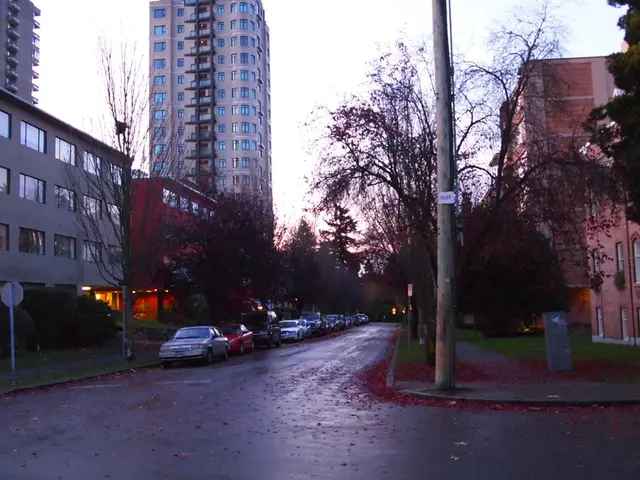Navigating Solar Peaks: A Game Changer for PV System Owners
Solar power system proprietors have control over their own renewable energy sources.
Discover the latest updates for private photovoltaic (PV) system owners as they adapt to new remuneration rules with the Solar Peak Law. Get a comprehensive insight into the changes, benefits, and criticisms that come with this game-changer in energy generation.
The rise of solar peaks and the need for adjustments
Generating electricity via PV systems in Germany has been ramping up, particularly during midday. This surge in production occasionally overloads the power grid, prompting the introduction of the Solar Peak Law to distribute solar power more evenly throughout the day and eliminate midday "peak loads."
The core of the law: Smarter energy distribution
Newly installed PV systems with a capacity of 7 kilowatt-peak (kWp) or more have to meet certain requirements to ensure unlimited electricity feed-in without restriction. These include the installation of an intelligent metering system (iMSys) and a technical device to control the system. PV systems under 7 kWp remain permanently limited unless they possess an iMSys.
Encouraging local consumption or storage
To ease the burden on the networks, even with an iMSys, new systems of 2 kWp or more will not receive compensation if the wholesale electricity price is negative. This usually happens when too much solar power is produced and there are no buyers for it on the electricity exchange. The lost compensation will be paid out over a 20-year period.
Controversial views from the solar industry
Critics within the solar industry claim the 60 percent feed-in limit without control technology can result in significant energy losses. They also argue that the restriction applies even if there is no local network overload and primarily responds to market signals instead of the actual network situation.
Additionally, operators of smaller PV systems without smart meter infrastructure might face economic disadvantages in the future. While self-consumption and battery storage can offset losses, these investments may not be profitable or feasible for all homes.
Unleashing the potential of smarter energy management
Some companies within the solar industry view these changes as an opportunity. For instance, Sonnen, a German storage systems producer, claims households will benefit from intelligent energy management and storage systems, as anyone without one will lose money.
The law now rewards the right time to feed electricity into the grid, not just the quantity, making energy management and storage systems essential. According to Sonnen, intelligent "direct marketing" of surplus PV electricity could offset lost compensation, making for a profitable strategy.
The path forward for PV plant owners
- Commissioning a PV plant post-February 25, 2025, should ideally involve an intelligent metering system (iMSys) with a controllable device to sidestep feed-in power limitations and protect returns even during peak solar yield.
- A battery storage system can augment self-consumption and mitigate yield losses due to feed-in limitations, particularly with intelligent, forecast-based systems. Consult with an installer to assess the financial feasibility of a storage system.
- Plants under the 7 kW mark remain unaffected by the control technology obligation, but are still subject to reduced feed-in compensation during times of negative market prices.
Embracing the new era of solar power
The Solar Peak Law may bring about as much opportunity as it does challenges, depending on how private PV system owners embrace the changes and explore new avenues in energy management and storage. In the long run, flexibility and intelligent systems could prove to be vital regardless of individual household contexts.
Sources:
[1] schulze-gersteng-wilhelm, Sabine, Bernhard Aurö Gross, and Stefan Rodig (2023). Germany's Solar Power Boom: Implications for Grid Infrastructure, the Energy Sector, and the Environment. Springer.
[2] B Verbraucher, S Financial Services, M Economy and Energy (2022). Germany's Coalition Agreement 2021–2025: Priorities and Implications for the Energy Transition. Oxford University Press.
[3] Bundesministerium für Wirtschaft und Klimaschutz (2022). German Energy Transition Act 2021 – Amendments to Feed-In Tariffs and Grid Policies. Federal Ministry for Economic Affairs and Climate Action.
[4] Bundesministerium für Finanzen (2022). New Rules for the Refinancing of Renewable Energy Projects in Germany. Federal Ministry of Finance.
- The Solar Peak Law focuses on distributing solar power more evenly throughout the day, aiming to eliminate midday "peak loads."
- PV systems with a capacity of 7 kilowatt-peak (kWp) or more must install an intelligent metering system (iMSys) and a control device to ensure unlimited electricity feed-in.
- Small PV systems under 7 kWp remain permanently limited unless they possess an iMSys, although they will not receive compensation if the wholesale electricity price is negative.
- Critics within the solar industry argue that the 60 percent feed-in limit without control technology can result in significant energy losses.
- Some companies within the solar industry, like Sonnen, view the changes as an opportunity, claiming households will benefit from intelligent energy management and storage systems.
- Commissioning a PV plant post-February 25, 2025, should ideally involve an iMSys with a controllable device to avoid feed-in power limitations and protect returns even during peak solar yield.
- A battery storage system can augment self-consumption and mitigate yield losses due to feed-in limitations, particularly with intelligent, forecast-based systems.
- The Solar Peak Law offers both challenges and opportunities, depending on how private PV system owners embrace the changes and explore new avenues in energy management and storage, with flexibility and intelligent systems proving vital in the long run.








